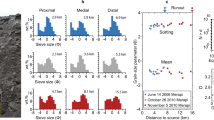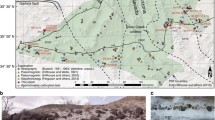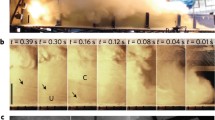Abstract
Active volcanoes are an incredible source of loose material, pyroclastic fragments that emplace as rain or flow on their slopes, forming m-thick deposits during explosive eruption. In particular, eruptive columns can elevate through the atmosphere for several kilometers, from which ash and pyroclastic fragments can fall, mantling the surrounding area, or can flow as turbulent, hot, pyroclastic flows. A pyroclastic flow mainly consists of a dry, basal, granular avalanche that moves along the volcanic slope, overrunned by a dilute, turbulent mixture of hot gas and fine ash. During heavy rains or abrupt release of water (such a dam failure or glacier outburst), these unconsolidated deposits can be easily eroded and remobilized as lahars, a two-phase mixture of water and granular material. These gravity-driven volcaniclastic flows are usually studied based on their deposits, where gas or water are no longer present, limiting our understanding of particle-particle or fluid-particle interaction. Numerical and analog modeling have been used to study their behavior, as well as the laws governing energy transfer between particles, and between the flow and the substratum. The mobility of a pyroclastic flow is greatly controlled by the current’s mass and height of generation (potential energy), the efficiency of conversion from potential to kinetic energy within the current (i.e. loss of momentum due to frictional processes both within the current and at its edges), and the rate of atmospheric air entrainment. Lahars, in addition to the above-mentioned factors, are still more intricate since the rheology of the fluid phase (water plus fines) can modify the particle interactions, preventing energy dissipation and improving their mobility. In contrast to lahars, where real-time data is frequently collected, pyroclastic flows are rarely studied syn-eruptive due to their high velocities (35 m/s in average) and high temperatures (400 °C on average) making direct data collection extremely challenging, for which only few examples are available in the literature, Real-time data, however, are of paramount importance since they can provide a radiography of the flow behavior and of the mechanisms of emplacement, having crucial implications on hazard assessment. Volcán de Colima is a natural laboratory for studying volcaniclastic gravity flows. Most recent 2004–2005, 2013, and 2015 pyroclastic flows were produced by summit dome collapses; the latest of which represented the last 100 years’ largest eruption. In contrast, lahars develop every year during the rainy season at a minimum 20 event/year rate inside the main ravines draining the volcano’s southern sector. Since 2011, a monitoring network has been installed to get visual and seismic data from lahars, aiming at understanding their behavior and the mechanisms of transport, which depend on sediment content and on the interaction between flow, substratum and channel walls morphology. In 2015, the transit of a pyroclastic flow, never before recorded at an active volcano, was registered by one monitoring station. From these data, it was possible to better describe energy transfer between particles, and between particle and substratum, and to demonstrate that at least 1/3 of the total flow energy dissipates at channel walls. The latest conclusion was revealing since most numerical models used at reproducing gravity flow for hazard assessment, only considered energy dissipation at the substratum, overestimating flow maximum runout. More in detail, the seismic data, coupled with images of the event and field data, enabled discriminating flow sediment content, and implementing a real-time warning system to alert villages settled around main ravines. Our data demonstrate that more work is needed, and that only a multidisciplinary approach can solve yet undiscovered volcaniclastic flow internal behaviors.
Access this chapter
Tax calculation will be finalised at checkout
Purchases are for personal use only
Similar content being viewed by others
References
S.K. Brown, S.F. Jenkins, R.S.J. Sparks, H. Odbert, M.R. Auker, Volcanic fatalities database: analysis of volcanic threat with distance and victim classification. J Appl Volcanol 6, 15 (2017)
G. Lube, E.C.P. Breard, T. Esposti-Ongaro, J. Dufek, B. Brand, Multiphase flow behaviour and hazard prediction of pyroclastic density currents. Nat. Rev. Earth Environ. 1(7), 348–365 (2020)
R. Sulpizio, P. Dellino, D.M. Doronzo, D. Sarocchi, Pyroclastic density currents: state of the art and perspectives. J. Volcanol. Geotherm. Res. 283, 36–65 (2014)
J. Dufek, T. Esposti-Ongaro, O. Roche, Pyroclastic density currents: processes and models, in The Encyclopedia of Volcanoes, (Academic Press, 2015), pp. 617–629
L. Capra, R. Sulpizio, V.H. Márquez-Ramirez, V. Coviello, R. Arambula-Mendoza, S. Cruz, The anatomy of a pyroclastic density current: the 10 July 2015 event at Volcán de Colima (Mexico). Bull. Volcanol. 80(4), 34 (2018)
T. Esposti-Ongaro, A.B. Clarke, A. Neri, B. Voight, C. Widiwijayanti, Fluid dynamics of the 1997 Boxing Day volcanic blast on Montserrat, West Indies. J. Geophys. Res. 113(B03211) (2008)
F. Maeno, S. Nakada, M. Yoshimoto, T. Shimano, N. Hokanishi, A. Zaennudin, M. Iguchi, A sequence of a plinian eruption preceded by dome destruction at Kelud volcano, Indonesia, on February 13, 2014, revealed from tephra fallout and pyroclastic density current deposits. J. Volcanol. Geotherm. Res. 382, 24–41 (2019)
B. Behncke, Hazards from pyroclastic density currents at Mt. Etna (Italy). J. Volcanol. Geotherm. Res. 180, 148–160 (2009)
V. Manville, K. Németh, K. Kano, Source to sink: a review of three decades of progress in the understanding of volcaniclastic processes, deposits, and hazards. Sediment. Geol. 220(3–4), 136–161 (2009)
T.C. Pierson, Hyperconcentrated flow—Transitional process between water flow and debris flow, in Debris-Flow Hazards and Related Phenomena, (Springer, Berlin, 2005), pp. 159–202
T.C. Pierson, J.E. Costa, W. Vancouver, A rheologic classification of subaerial sediment-water flows. Debris flows/avalanches: process, recognition, and mitigation. reviews in engineering geology. Geol. Soc. Am. 7, 1–12 (1987)
J.W. Vallance, K.M. Scott, The osceola mudflow from mount rainier: sedimentology and hazard implications of a huge clay-rich debris flow. Geol. Soc. Am. Bull. 109, 143–163 (1997)
S.R. Mead, C. Magill, V. Lemiale, S.R. Mead, C. Magill, V. Lemiale, J.C. Thouret, M. Prakash, Examining the impact of lahars on buildings using numerical modelling. Nat. Hazards Earth Syst. Sci. 17(5), 703–719 (2017)
J.W. Vallance, R.M. Iverson, Lahars and their deposits, in The Encyclopedia of Volcanoes, (Academic Press, 2015), pp. 649–664
J.P. Beverage, J.K. Culbertson, Hyperconcentrations of suspended sediment. J. Hydraul. Div. 90(6), 117–128 (1964)
T.C. Pierson, Flow behavior of channelized debris flows. Mount St. Helens, Washington, in Hillslope processes, (Routledge, 1986), pp. 269–296
M.T. Pareschi, Physical modeling of eruptive phenomena: Lahars. Monitoring and Mitigation of Volcano Hazards, 463–489 (1996)
V. Manville, J.J. Major, S. Fagents, Modeling lahar behavior and hazards, in Modeling Volcanic Processes: The Physics and Mathematics of Volcanism, ed. by S. A. Fagents, T. K. P. Gregg, R. M. C. Lopes, (Cambridge University Press, 2013), pp. 300–330
P. Coussot, D. Laigle, M. Arattano, P. Coussot, D. Laigle, M. Arattano, A. Deganutti, L. Marchi, Direct determination of rheological characteristics of debris flow. J. Hydraul. Eng. 124(8), 865–868 (1998)
J.J. Major, T.C. Pierson, Debris flow rheology: experimental analysis of fine-grained slurries. Water Resour. Res. 28(3), 841–857 (1992)
R.A. Bagnold, Experiments on a gravity-free dispersion of large solid spheres in a Newtonian fluid under shear. Proc R Soc Lond Ser A Math Phys Sci 225(1160), 49–63 (1954)
T. Takahashi, Debris flow on prismatic open channel. J. Hydraul. Div. 106(3), 381–396 (1980)
P.Y. Julien, J.S. O’Brien, Selected notes on debris flow dynamics, in Recent Developments on Debris Flows, (Springer, Berlin, 2007), pp. 144–162
J.S. O’Brien, P.Y. Julien, W.T. Fullerton, Two-dimensional water flood and mudflow simulation. J. Hydraul. Eng. 119(2), 244–261 (1993)
R.M. Iverson, R.P. Denlinger, Flow of variably fluidized granular masses across three-dimensional terrain: 1. Coulomb mixture theory. J. Geophys. Res. Solid Earth 106, 537–552 (2001)
J.-C. Thouret, S. Antoine, C. Magill, C. Ollier, Lahars and debris flows: characteristics and impacts. Earth-Sci. Rev. 201, 103003 (2019)
S.P. Pudasaini, K. Hutter, Avalanche Dynamics: Dynamics of Rapid Flows of Dense Granular Avalanches (Springer Science & Business Media, 2007)
J. Gray, Particle segregation in dense granular flows. Annu. Rev. Fluid Mech. 50, 407–433 (2018)
Y.-J. Jiang, X.-Y. Fan, T.-H. Li, S.-Y. Xiao, Influence of particle-size segregation on the impact of dry granular flow. Powder Technol. 340, 39–51 (2018)
S.B. Savage, K. Hutter, The dynamics of avalanches of granular materials from initiation to runout. Part I: Analysis. Acta Mechanica 86(1), 201–223 (1991)
P. Bartelt, B. Salm, U. Gruber, Calculating dense-snow avalanche runout using a Voellmy-fluid model with active/passive longitudinal staining. J. Glaciol. 45, 242–254 (1999)
E. Breard, J. Dufek, O. Roche, Continuum modeling of pressure-balanced and fluidized granular flows in 2-D: Comparison with glass bead experiments and implications for concentrated pyroclastic density currents. J. Geophys. Res. Solid Earth 124(6), 5557–5583 (2019)
R.M. Iverson, The physics of debris flows. Rev. Geophys. 35(3), 245 (1997)
R. Bartali, G.M. Rodríguez-Liñán, L. Torres-Cisneros, G. Pérez-Ángel, Y. Nahmad-Molinari, Runout transition and clustering instability in binary-mixture avalanche deposits. Granul. Matter 22, 1–18 (2020)
R. Bartali, D. Sarocchi, Y. Nahmad-Molinari, Stick-slip motion and high-speed ejecta in granular avalanches detected through multi-sensors flume. Eng. Geol. 195, 248–257 (2015)
H.J. Herrmann, Molecular dynamics simulations of granular materials. Int. J. Mod. Phys. C 4(2), 309–316 (1993)
G. Pérez, Numerical simulations in granular matter: the discharge of a 2D silo. Pramana J. Phys. 70(6), 989–1007 (2008)
S. Gottlieb, C.W. Shu, E. Tadmor, Strong stability-preserving high-order time discretization methods. SIAM Rev. 43(1), 89–112 (2001)
T. Pöschel, T. Schwager, Computational Granular Dynamics (Springer Science & Business Media, 2005)
J. Shäfer, S. Dippel, D. Wolf, Force schemes in simulations of granular materials. J. Phys. 6(1), 5–20 (1996)
T. Schwager, T. Pöschel, Coefficient of restitution and linear-dashpot model revisited. Granul. Matter 9(6), 465–469 (2007)
P.A. Cundall, O.D.L. Strack, A discrete numerical model for granular assemblies. Geotechnique 29(1), 47–65 (1979)
L. Brendel, S. Dippel, Lasting contacts in molecular dynamics simulations. Phys. Dry Granular Media NATO ASI Ser. E 350, 313–318 (1998)
N. Naito, K. Maeda, H. Konno, Y. Ushiwatari, K. Suzuki, R. Kawase, Rockfall impacts on sand cushions with different soil mechanical characteristics using discrete element method. Soils Found. 60(2), 384–397 (2020)
R.M. Iverson, Landslide disparities, flume discoveries, and oso despair. Perspect. Earth Space Sci. 1 (2020)
M. Hürlimann, V. Coviello, C. Bel, X. Guo, M. Berti, C. Graf, J. Hübl, S. Miyata, J.B. Smith, H.Y. Yin, Debris-flow monitoring and warning: review and examples. Earth Sci. Rev. 199, 102981 (2019)
K.E. Allstadt, M. Farin, A.B. Lockhart, S.K. McBride, J.W. Kean, R.M. Iverson et al., Overcoming barriers to progress in seismic monitoring and characterization of debris flows and lahars, in Proceedings of the Seventh International Conference on Debris-Flow Hazards Mitigation, Golden, CO, 2019
V. Coviello, L. Capra, R. Vázquez, V.H. Márquez-Ramirez, Seismic characterization of hyperconcentrated flows in a volcanic environment. Earth Surf. Process. Landf. 43(10), 2219–2231 (2018)
R. Vázquez, E. Surinach, L. Capra, R. Arambula, G. Reyes, Seismic characterisation of lahars at Volcán de Colima, Mexico. Bull. Volcanol. 78(2), 1–14 (2016)
B. Walsh, V. Coviello, L. Capra, J. Procter, V. Márquez, Insights on the internal dynamics of natural lahars from the analysis of 3-component broadband seismic signals. Front. Earth Sci. 8, 632 (2020)
V. Coviello, M. Arattano, F. Comiti, P. Macconi, L. Marchi, Seismic characterization of debris flows: insights into energy radiation and implications for warning. J. Geophys. Res. Earth Surf. 124(6), 1440–1463 (2019)
R.M. Iverson, S.P. Schilling, J.W. Vallance, Objective delineation of lahar-inundation hazard zones. Geol. Soc. Am. Bull. 110(8), 972–984 (1998)
M.C. Malin, M.F. Sheridan, Computer-assisted mapping of pyroclastic surges. Science 217, 637–640 (1982). doi: 10.1126/science.217.4560.637
A.K. Patra, A.C. Bauer, C.C. Nichita, E.B. Pitman, M.F. Sheridan, M. Bursik, B. Rupp, A. Webber, A.J. Stinton, Namikawa, & L. M., Renschler, C. S., Parallel adaptive numerical simulation of dry avalanches over natural terrain. J. Volcanol. Geotherm. Res. 139(1–2), 1–21 (2005)
E.B. Pitman, C. Nichita, A. Patra, Computing granular avalanches and landslides. Phys. Fluids 15(12), 3638–3646 (2003)
K. Kelfoun, T.H. Druitt, Numerical modeling of the emplacement of Socompa Rock Avalanche, Chile. J. Geophys. Res. Solid Earth 110(B12) (2005)
L. Capra, V.C. Manea, M. Manea, G. Norini, The importance of digital elevation model resolution on granular flow simulations: a test case for Colima Volcano usingTITAN2D computational routine. Nat. Hazards 59(2), 665–680 (2011)
N.F. Stevens, V. Manville, D.W. Heron, The sensitivity of a volcanic flow model to digital elevation model accuracy: experiments with digitised map contours and interferometric SAR at Ruapehu and Taranaki volcanoes, New Zealand. J. Volcanol. Geotherm. Res. 119(1–4), 89–105 (2003)
J.J. O’Brien, P.Y. Julien, Physical properties and mechanics of hyperconcentrated deiment flows. Proc. ASCE Speciality Conference on the Delineation of landslide, Flashflood and debrisl flow hazards, Utah Water Lad, Series UWRL/G-85/03, 260–279 (1985)
A.L. Martin del Pozzo, M. Alatorre, L. Arana, R. Bonasia, L. Capra, W. Cassata, et al., Estudios geológicos y actualización del mapa de peligros del volcán Popocatépetl (Memoria técnica del mapa de peligros del volcán Popocatépetl: Monografías del Instituto de Geofísica, 2017), p. 22
K. Sieron, D. Ferres, C. Siebe, R. Constantinescu, L. Capra, C. Connor, L. Connor, G. Groppelli, K. González Zuccolotto, Ceboruco hazard map: Part II—Modeling volcanic phenomena and construction of the general hazard map. Nat. Hazards 96(2), 893–933 (2019)
R. Vázquez, J.L. Macías, J.L. Arce, Integrated hazards maps of the Tacaná Volcanic complex, Mexico-Guatemala: ashfall, block-and-ash flows, and lahars. J. S. Am. Earth Sci. 107, 103146 (2021)
L. Capra, J.C. Gavilanes-Ruiz, R. Bonasia, R. Saucedo, R. Sulpizio, Re-assessing volcanic hazard zonation of Volcán de Colima, México. Nat. Hazards 76(1), 41–61 (2015)
Acknowledgements
We thank Luis Albeto Aguilar, Alejandro de León and Jair García of the Laboratorio Nacional de Visualización Científica Avanzada (UNAM) for their support during TITAN2D computer simulations. GMR would like to thank the Cátedras Conacyt fellowship program for supporting this research.
Author information
Authors and Affiliations
Corresponding author
Editor information
Editors and Affiliations
Rights and permissions
Copyright information
© 2022 The Author(s), under exclusive license to Springer Nature Switzerland AG
About this chapter
Cite this chapter
Rodríguez-Liñán, G.M., Torres-Orozco, R., Márquez, V.H., Capra, L., Coviello, V. (2022). The Physics of Granular Natural Flows in Volcanic Environments. In: Hernández-Dueñas, G., Moreles, M.A. (eds) Mathematical and Computational Models of Flows and Waves in Geophysics. CIMAT Lectures in Mathematical Sciences. Birkhäuser, Cham. https://doi.org/10.1007/978-3-031-12007-7_4
Download citation
DOI: https://doi.org/10.1007/978-3-031-12007-7_4
Published:
Publisher Name: Birkhäuser, Cham
Print ISBN: 978-3-031-12006-0
Online ISBN: 978-3-031-12007-7
eBook Packages: Mathematics and StatisticsMathematics and Statistics (R0)




